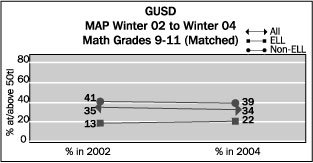Gilroy Unified School District Superintendent Edwin Diaz has
been giving power point presentations recently: at school board
meetings, to staff, and at forums.
Gilroy Unified School District Superintendent Edwin Diaz has been giving power point presentations recently: at school board meetings, to staff, and at forums. His “GUSD Presentation to Strategic Planning Core Team” includes a list of major challenges for the future, one of which is: “How do we reverse the trend of low and declining math performance for grades 9–12?”
The presentation also includes some data, specifically a graph of the MAP math scores for grades 9 through 12. This graph shows a slight decline in performance for English speaking students: in 2002, 41 percent were at or above grade level; in 2004, the number fell to 39 percent.
English language learners improved slightly over the same time frame: 19 percent were at or above grade level in 2002, rising to 22 percent in 2004. In short, English speaking students went from poor to worse, while ELL students went from abysmal to a shade less abysmal.
If the two groups are combined, the overall math performance of Gilroy’s high school students declined slightly, from 35 down to 34 percent of students at or above grade level, during that time frame.
That is the bad news.
The good news is that Superintendent Diaz has reviewed the data, and decided that these scores are unacceptable. Secondly, by including: “How do we reverse this trend?” on his Major Challenges list, he indicates that he intends that GUSD do what it can to improve the situation. Define the problem, decide to fix it: these are the essential first two steps in problem solving.
The future will show whether GUSD is actually able to solve this problem. I merely wish to point out one rather large obstacle in the path of any improvement in math performance at GHS.
That obstacle is Mr. Wayne Scott, GHS math teacher.
Mr. Scott has a new hobby this spring: writing letters to the editor. Mr. Scott has an interesting attitude toward statistics and scores; his constant refrain is that scores should only be looked at in context. I could agree with that, except that Mr. Scott seems to mean that he reserves the right to explain away bad scores, and not trouble to fix the problem.
Mr. Scott has even stated: “Analyzing AP and SAT data violates many of the basic tenets of statistics.” This statement is absurd. Statistics is the science of assembling, classifying, and tabulating data, whether said data be AP scores, SAT scores, or math teachers’ salaries.
With statistics, one can find the range, median, mode, mean, and standard deviation. One can find a percentile, for an individual student, for a class, for a school, or for a district. One can then compare one student to another, even one district to another.
The whole point of statistics is to analyze data. To say, as Mr. Scott does, “Students at GHS are not representative of students across the nation and there is no typical AP class anywhere,” is to say that statistics are useless. Perhaps Mr. Scott’s attitude explains why only 17 percent of his AP students passed their exam.
I have some questions about Mr. Scott. What classes does he teach? If he teaches sophomores, what percentage of them have passed the math portion of the exit exam? Exactly why does he think Saxon math would be a disaster at Gilroy High?
I would also like to know why, since Mr. Scott has a degree in secondary mathematics education and had a hand in the selection of the texts currently in use, Gilroy High School’s math performance continues to be so poor, and especially why GHS is finding it necessary to apply for a waiver from the requirement that all high school students complete a year of algebra.
Lastly, I would like to know why Mr. Scott finds it necessary to waste valuable class time chatting to his students about this flame-war he is conducting on the Opinion page. For one thing, Mr. Scott’s attitudes, as expressed in class and in The Dispatch, contradict Superintendent Diaz’s stated intent to examine the data and attempt to improve the demonstrably poor performance.
More importantly, as a taxpayer, I would rather he used his class time on conic sections and the chain rule. That is what I am paying him to do.














